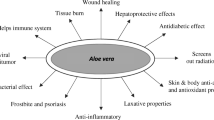Abstract
An analysis using HPLC–MS revealed that an extract from dried leaves of Apocynum venetum L. contained more than 15 kinds of phenolic constituents. Two malonated flavonol glycosides were further isolated, and their structures were determined to be quercetin 3-O-(6′′-O-malonyl)-β-d-glucoside (1) and quercetin 3-O-(6′′-O-malonyl)-β-d-galactoside (2) by NMR spectroscopic analysis. This is the first report describing the isolation of these malonated flavonol glycosides from A. venetum L. Both glycosides showed strong scavenging activity against 1, 1-diphenyl-2-picrylhydrazyl (DPPH) radical.



Similar content being viewed by others
References
The Pharmacopoeia Committee of the Health Ministry of the People’s Republic of China (ed) (2000) Pharmacopeia of People’s Republic of China, part 1. Chemical Technologic Publisher, Beijing
Xiong Q, Fan W, Tezuka Y, Adnyana IK, Stampoulis P, Hattori M, Namba T, Kadota S (2000) Hepatoprotective effect of Apocynum venetum and its active constituents. Planta Med 66:127–133
Yokozawa T, Kashiwada Y, Hattori M, Chung HY (2002) Study on the components of Luobuma with peroxynitrite-scavenging activity. Biol Pharm Bull 25:748–752
Butterweck V, Nishibe S, Sasaki T, Uchida M (2001) Antidepressant effects of Apocynum venetum leaves in forced swimming test. Biol Pharm Bull 24:848–851
Butterweck V, Simbrey K, Seo S, Sasaki T, Nishibe S (2003) Long-term effects of an Apocynum venetum extract on brain monoamine levels and β-AR density in rats. Pharmacol Biochem Behav 75:557–564
Grundmann O, Nakajima J, Seo S, Butterweck V (2007) Anti-anxiety effects of Apocynum venetum L. in the elevated plus maze test. J Ethnopharmacol 110:406–411
Fan W, Tezuka Y, Xiong Q, Hattori M, Namba T, Kadota S (1999) Apocynins A–D: new phenylpropanoid-substituted flavan-3-ols isolated from leaves of Apocynum venetum (Luobuma-Ye). Chem Pharm Bull 47:1049–1050
Murakami M, Kishi A, Matsuda H, Hattori M, Yoshikawa M (2001) Medicinal foodstuffs, XXIV, chemical constitution of the processed leaves of Apocynum venetum L,: absolute stereostructures of aposinoside I and II. Chem Pharm Bull 49:845–848
Ferreres F, Gil IM, Castañer M, Tomás-Barberán AF (1997) Phenolic metabolites in red pigmented lettuce (Lactuca sativa). Changes with minimal processing and cold storage. J Agric Food Chem 45:4249–4254
Wald B, Wray V, Galensa R, Herrmann K (1989) Malonated flavonol glycosides and 3,5-dicaffeoylquinic acid from pears. Phytochemistry 28:663–664
Geslin M, Verbist JF (1985) Flavonoides de Salicornia europaea. J Nat Pro 48:111–113
Azuma K, Nakayama M, Koshioka M, Ippoushi K, Yamaguchi Y, Kohata K, Yamauchi Y, Ito H, Higashio H (1999) Phenolic antioxidants from the leaves of Corchorus olitorius L. J Agric Food Chem 47:3963–3966
Imperato F (1982) A new acylated flavonol glycoside from the fern Adiantum capillus-veneris L. Chem Ind 21:604
Blois MS (1958) Antioxidant determinations by the use of a stable free radical. Nature 181:1199–1200
Butterweck V, Jürgenliemk G, Nahrstedt A, Winterhoff H (2000) Flavonoids from Hypericum perforatum show antidepressant activity in the forced swimming test. Planta Med 66:3–6
Sakakibara H, Ishida K, Grundmann O, Nakajima J, Seo S, Butterweck V, Minami Y, Saito S, Kawai Y, Nakaya Y, Terao J (2006) Antidepressant effect of extracts from Ginkgo biloba leaves in behavioral models. Biol Pharm Bull 29:1767–1770
Acknowledgment
We thank Prof. Hiromitsu Takayama (Chiba University) for his measurement of the 1H and 13C NMR spectra.
Author information
Authors and Affiliations
Corresponding author
Rights and permissions
About this article
Cite this article
Kamata, K., Seo, S. & Nakajima, Ji. Constituents from leaves of Apocynum venetum L.. J Nat Med 62, 160–163 (2008). https://doi.org/10.1007/s11418-007-0202-3
Received:
Accepted:
Published:
Issue Date:
DOI: https://doi.org/10.1007/s11418-007-0202-3




